The real-time full database synchronization feature combines a one-time full migration with continuous incremental capture to sync an entire source database, such as MySQL or Oracle, to a target system with low latency. This task first performs a full synchronization of historical data from the source database and automatically initializes the table schemas and data in the target. Then, it automatically switches to a real-time incremental mode, using technologies such as Change Data Capture (CDC) to continuously capture and sync subsequent data changes. This feature is suitable for scenarios such as building real-time data warehouses and data lakes. This topic uses the real-time synchronization of a full MySQL database to MaxCompute as an example to describe how to configure the task.
Preparations
Data source preparation
Create source and target data sources. For more information about data source configuration, see Data Source Management.
Ensure that the data sources support real-time full database synchronization. For more information, see Supported data sources and synchronization solutions.
For some data sources, such as Hologres and Oracle, you must enable logging. The method for enabling logging varies by data source. For more information, see Data Source List.
Resource group: Purchase and configure a Serverless resource group.
Network connectivity: Complete the network connectivity configuration between the resource group and the data sources.
Access the feature
Log on to the DataWorks console. In the top navigation bar, select the desired region. In the left-side navigation pane, choose . On the page that appears, select the desired workspace from the drop-down list and click Go to Data Integration.
Limits
DataWorks supports two types of full database synchronization: real-time and full and incremental (Near Real-Time). Both types can perform a full synchronization of historical data from the source database and then automatically switch to an incremental mode. However, they differ in terms of timeliness and requirements for the target table:
Timeliness: Real-time full database synchronization has a latency of seconds to minutes. Full and incremental (Near Real-Time) synchronization has a T+1 latency.
Target table (MaxCompute): Real-time full database synchronization only supports tables of the Delta tables type. Full and incremental (Near Real-Time) synchronization supports all table types.
Configure the task
1. Create a sync task
You can create a sync task in one of the following two ways:
Method 1: On the sync task page, select a Source and a Destination, and then click Create Synchronization Task. In this example, select MySQL for the source and MaxCompute for the destination.
Method 2: On the sync task page, if the task list is empty, click Create.

2. Basic Settings
Configure basic information such as the task name, description, and owner.
Select a sync type. Data Integration displays the supported Task Type options based on the source and destination database types. In this topic, select Real-time migration of entire database.
Synchronization steps:
Structural migration: Automatically creates database objects (such as tables, fields, and data types) in the target that match the source. This step does not include data.
Full initialization (Optional): Copies all historical data from specified source objects (such as tables) to the target in a single operation. This is typically used for initial data migration or data initialization.
Incremental synchronization (Optional): After the full synchronization is complete, continuously captures and syncs subsequent data changes (inserts, updates, and deletes) from the source to the target.
3. Configure network and resources
In the Network And Resource Configuration section, select the Resource Group for the sync task. You can assign a number of CUs to the Task Resource Usage.
Set Source to the added
MySQLdata source and Destination to the addedMaxComputedata source. Then, click Test Connectivity.
After ensuring that both the source and target data sources are successfully connected, click Next.
4. Select the databases and tables to sync
In the Source Table area, select the tables to sync from the source data source. Click the ![]() icon to move the tables to the Selected Tables list.
icon to move the tables to the Selected Tables list.
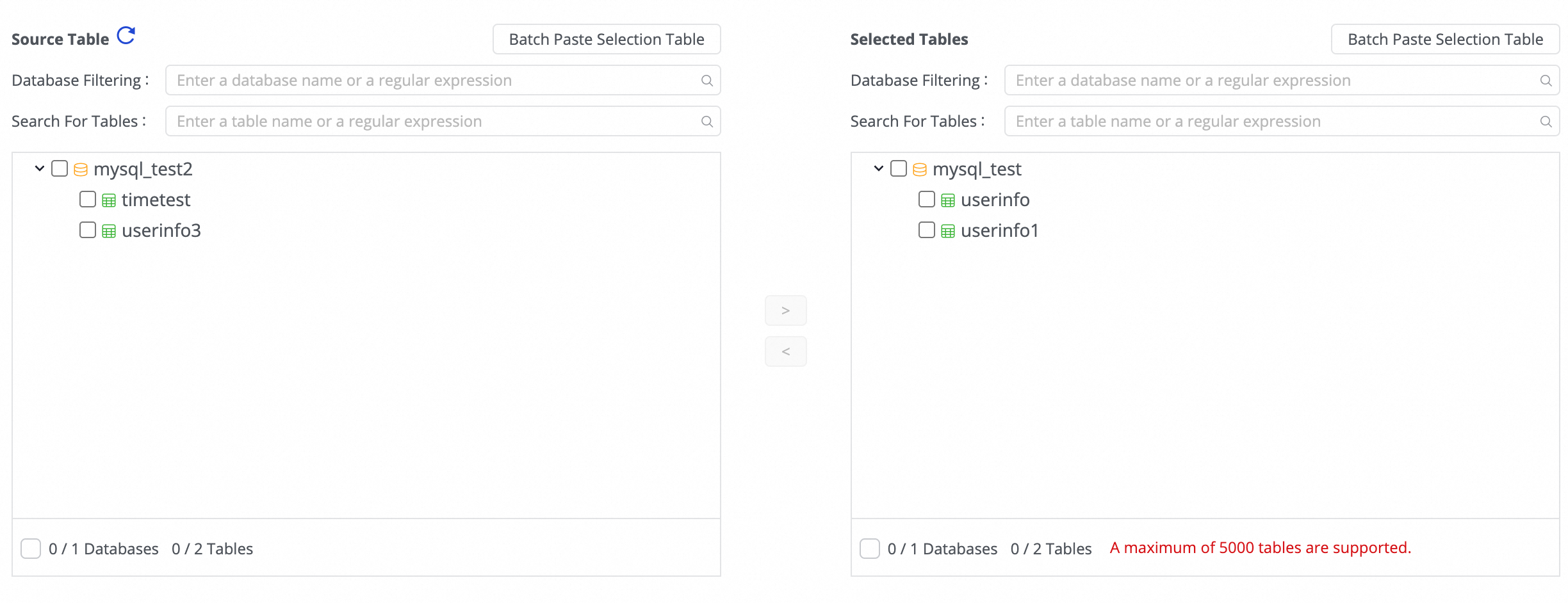
If there are many databases or tables, you can use Database Filtering or Database Filtering to select the tables to sync by configuring a regular expression.
5. Map to target tables
In this step, you can define the mapping rules between source and target tables. You can also specify rules for primary keys, dynamic partitions, and DDL/DML configurations to determine how data is written.
Operation | Description | ||||||||||||
Refresh | The system automatically lists the source tables you selected. However, the specific properties of the target tables take effect only after you refresh and confirm them.
| ||||||||||||
Customize Target Table Name Mapping (Optional) | The system has a default table name generation rule:
This allows for the following scenarios:
| ||||||||||||
Edit Mapping of Field Data Types (Optional) | The system has a default mapping between source and target field types. You can click Edit Mapping of Field Data Types in the upper-right corner of the table to customize the mapping relationship. After configuration, click Apply And Refresh Mapping. When editing field type mappings, ensure the conversion rules are correct. Otherwise, type conversion failures can produce dirty data and affect task execution. | ||||||||||||
Edit Target Table Schema (Optional) | The system automatically creates a target table if it does not exist, or reuses an existing table with the same name, based on the custom table name mapping rule. DataWorks automatically generates the target table schema based on the source table schema. In most scenarios, no manual intervention is needed. You can also modify the table schema in the following ways:
For existing tables, you can only add fields. For new tables, you can add fields and partition fields, and set the table type or table properties. For more information, see the editable areas in the interface. | ||||||||||||
Assign Values To Target Table Fields | Native fields are automatically mapped based on matching field names in the source and target tables. You must manually assign values for the new fields and partition fields added in the previous step. Perform the following operations:
You can assign constants and variables. Switch the type in Manually Assign Value. The following methods are supported:
Note Note that creating too many partitions affects synchronization efficiency. If more than 1,000 new partitions are created in a single day, partition creation fails and the task is terminated. Therefore, when defining the assignment method for partition fields, you need to estimate the number of partitions that might be generated. Use caution when creating partitions at the second or millisecond level. | ||||||||||||
Source Split Column | You can select a field from the source table in the source sharding column drop-down list or select Not Split. When the sync task runs, it will be split into multiple tasks based on this field to read data concurrently and in batches. We recommend using the table's primary key as the source sharding column. String, float, date, and other types are not supported. Currently, the source sharding column is supported only when the source is MySQL. | ||||||||||||
Do Execute Once Offline | If you have configured full synchronization in step 3, you can choose to cancel the full data synchronization for a specific table. This is useful in scenarios where the full data has already been synced to the target using other methods. | ||||||||||||
Full Condition | Filter the source data during the full synchronization phase. Only write the where clause here. Do not include the where keyword. | ||||||||||||
Configure DML Rule | DML message processing is used for fine-grained filtering and control of change data ( | ||||||||||||
Other |
For a detailed introduction to Delta Tables, see Delta tables. |
6. Configure DDL handling
Some real-time synchronization links can detect metadata changes in the source table schema and notify the target. The target can then update accordingly or take other actions such as sending an alert, ignoring the change, or terminating the task.
Click Configure DDL Capability in the upper-right corner of the interface to set a corresponding processing policy for each type of change. The supported policies vary by channel.
Normal processing: The target processes the DDL change information from the source.
Ignore: Ignores the change message. The target is not modified.
Alert: Sends an alert to the user when this type of change occurs at the source. This must be used with Configure Alert Rule.
Error: Terminates the real-time full database synchronization task and sets its status to Error.
When a new column is added at the source and also created at the target through DDL synchronization, the system does not backfill data for the existing rows in the target table.
7. Other configurations
Alerting configuration
1. Add an alert
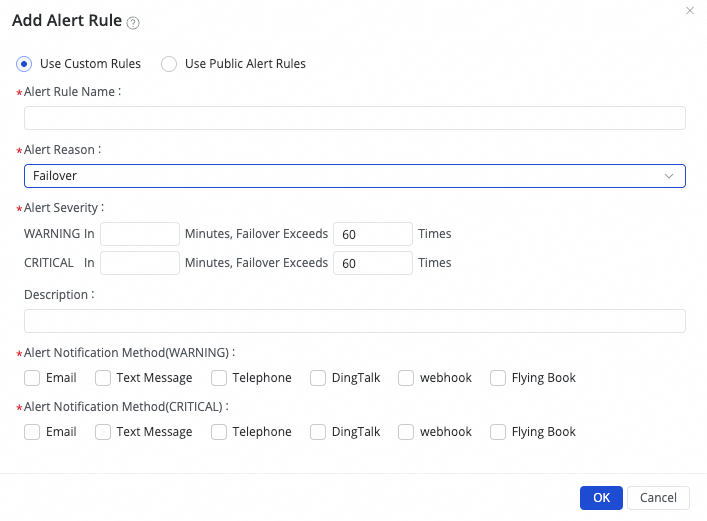
(1) Click Add Alert Rule to configure an alert rule.
You can set the Alert Reason to monitor metrics such as Business delay, Failover, Task Status, DDL Notification, and Task Resource Utilization. You can set CRITICAL or WARNING alert levels based on specified thresholds.
By setting Alerting Frequency Control, you can control the interval at which alert messages are sent. This prevents sending too many messages at once, which can cause waste and message accumulation.
(2) Manage alert rules.
For created alert rules, you can use the alert switch to enable or disable them. You can also send alerts to different personnel based on the alert level.
2. View alerts
Expand the task list, choose , and go to the alert events page to view alerts that have occurred.
Resource group configuration
The resource group used by the task and its configuration can be managed in the Configure Resource Group panel in the upper-right corner of the interface.
1. View and switch resource groups
Click Configure Resource Group to view the resource group currently bound to the task.
To change the resource group, you can switch to another available one in this panel.
2. Adjust resources and troubleshoot 'insufficient resources' errors
When the task log shows a message such as
Please confirm whether there are enough resources..., it means the available compute units (CUs) in the current resource group are insufficient for the task's startup or running requirements. In the Configure Resource Group panel, you can increase the number of CUs allocated to the task to provide more computing resources.
For recommended resource settings, see Recommended CUs for Data Integration. You may need to adjust the settings based on your requirements.
Advanced parameter settings
To perform fine-grained configuration for the task to meet custom synchronization requirements, click Configure in the Advanced Settings to modify advanced parameters.
Click Advanced Settings in the upper-right corner of the interface to go to the advanced parameter settings page.
Modify the parameter values according to the descriptions. The meaning of each parameter is explained next to its name.
Modify these parameters only if you fully understand their meaning. This helps avoid unexpected issues such as task latency, excessive resource consumption that blocks other tasks, or data loss.
8. Run the sync task
After you finish the configuration, click Complete at the bottom of the page.
On the page, find the created sync task and click Start in the Actions column.
In the Tasks, click the Name/ID of the task to view the execution details.
Edit the task
On the page, find the created sync task. In the Actions column, choose More > Edit to modify the task information. The steps are the same as for task configuration.
For a task that is Not Submitted, you can directly modify the configuration and then click Complete to save it.
For a task that is Submitted, after you modify the configuration, the original action button changes to Apply Updates. You must click this button for the changes to take effect in the online environment.
After you click Apply Updates, the system performs three steps on the changes: Stop, Publish, and Restart.
If the change involves adding a new table or switching an existing table:
You cannot select an offset when you apply the update. After you confirm, the system performs schema migration and full initialization for the new table. After the full initialization is complete, the new table starts incremental operations along with the other original tables.
If you modify other information:
You can select an offset when you apply the update. After you confirm, the task continues to run from the specified offset. If you do not specify an offset, it runs from the offset where it last stopped.
Unmodified tables are not affected. After the update and restart, they will continue to run from the offset where they last stopped.
View the task
After you create a sync task, you can view the list of created sync tasks and their basic information on the sync task page.

You can Start or Stop the sync task in the Actions column. In the More menu, you can perform operations such as editing and viewing the sync task.
For a started task, you can see the basic running status in the Execution Status. You can also click the corresponding overview area to view execution details.
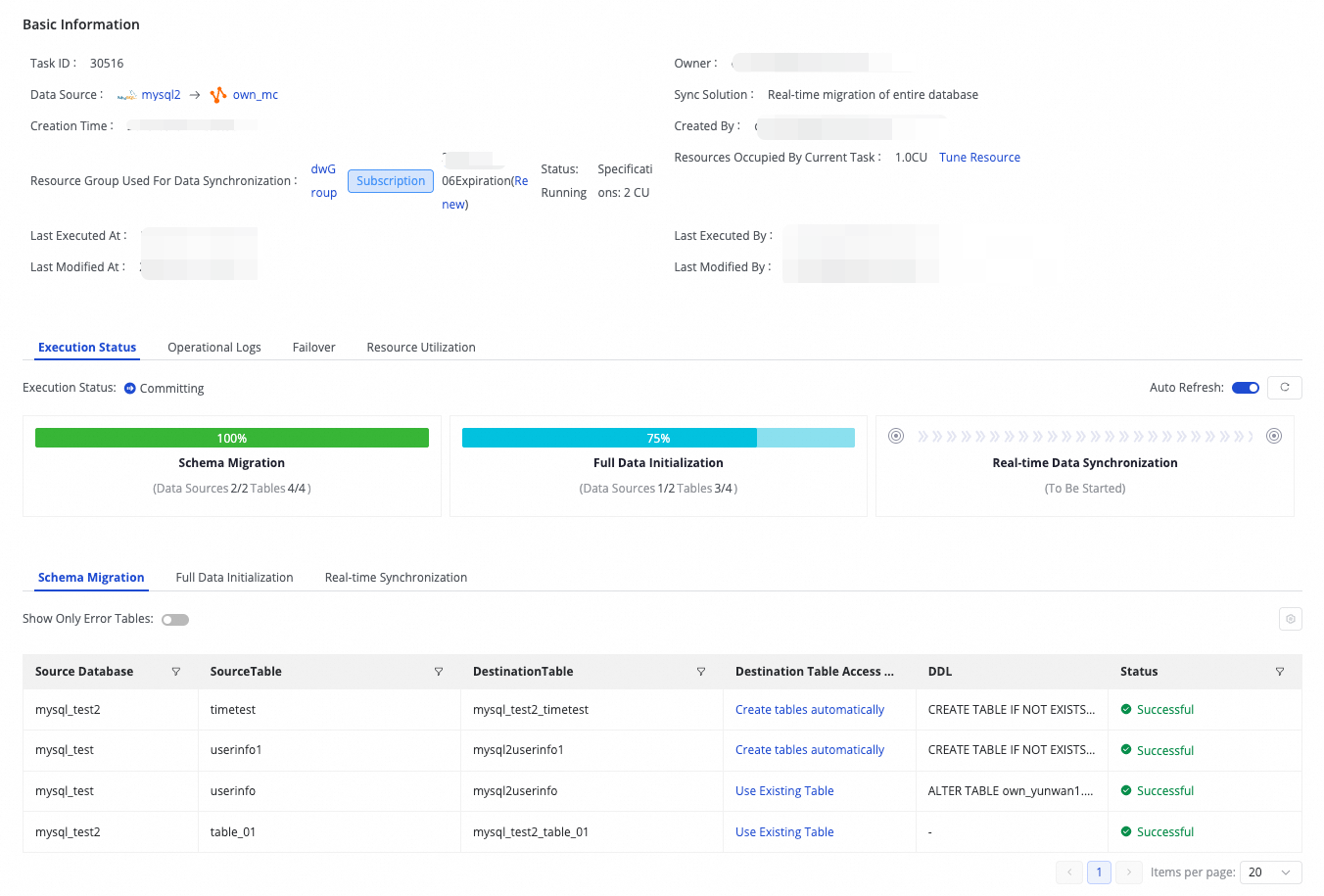
Resume from a breakpoint
Scenarios
Manually resetting the offset when you start or restart a task is useful in the following scenarios:
Task recovery and data continuation: When a task is interrupted for any reason, you may need to manually specify an interruption time point as the new start offset to ensure the task resumes from the correct breakpoint.
Data issue troubleshooting and backtracking: If you find that the synced data is lost or abnormal, you can roll back the offset to a time point before the problem occurred to replay and repair the problematic data.
Major changes to task configuration: After you make major adjustments to the task configuration (such as target table schema or field mapping), we recommend resetting the offset to start syncing from a clear time point. This ensures data accuracy with the new configuration.
Instructions
Click Start. In the pop-up window, select an option for Whether to reset the site:
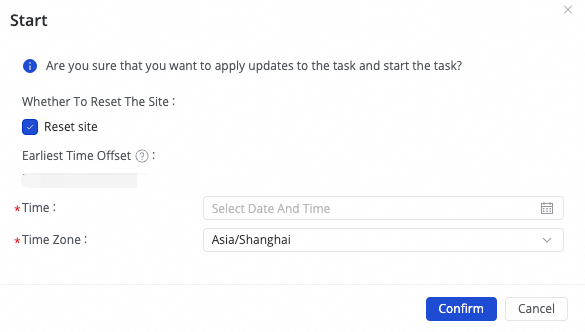
Do not reset the offset and run directly: The task continues to run from the offset where it last stopped (the last checkpoint).
Reset the offset and select a time: The task starts running from the specified time point. Make sure the selected time is not earlier than the earliest time point supported by the source's binary logging.
If you encounter an offset error or a 'does not exist' message when running the sync task, try the following solutions:
Reset the offset: When starting the real-time sync task, reset the offset and select the earliest available offset in the source database.
Adjust the log retention period: If the database offset has expired, consider adjusting the log retention period in the database, for example, to 7 days.
Data synchronization: If data has been lost, consider performing a full synchronization again, or configure an offline sync task to manually sync the lost data.
FAQ
For FAQs about real-time full database synchronization, see Real-time synchronization FAQ and Full and incremental synchronization task FAQ.
More examples
Real-time synchronization of a full MySQL database to AnalyticDB for MySQL 3.0
Real-time synchronization of a full MySQL database to OceanBase
Real-time ingestion of a full MySQL database into a Data Lake Formation data lake
Real-time synchronization of a full MySQL database to DataHub
Real-time synchronization of a full MySQL database to Elasticsearch
Real-time synchronization of a full MySQL database to Hologres
Real-time synchronization of a full MySQL database to LogHub (SLS)
Real-time synchronization of a full OceanBase database to MaxCompute
Real-time synchronization of a full Oracle database to MaxCompute
Real-time synchronization of a full MySQL database to an OSS data lake
Real-time synchronization of a full MySQL database to an OSS-HDFS data lake
Real-time synchronization of a full MySQL database to SelectDB
Real-time synchronization of a full MySQL database to StarRocks
 button and combining a Manual Input and a Built-in Variable. Supported variables include the source data source name, source database name, and source table name.
button and combining a Manual Input and a Built-in Variable. Supported variables include the source data source name, source database name, and source table name.

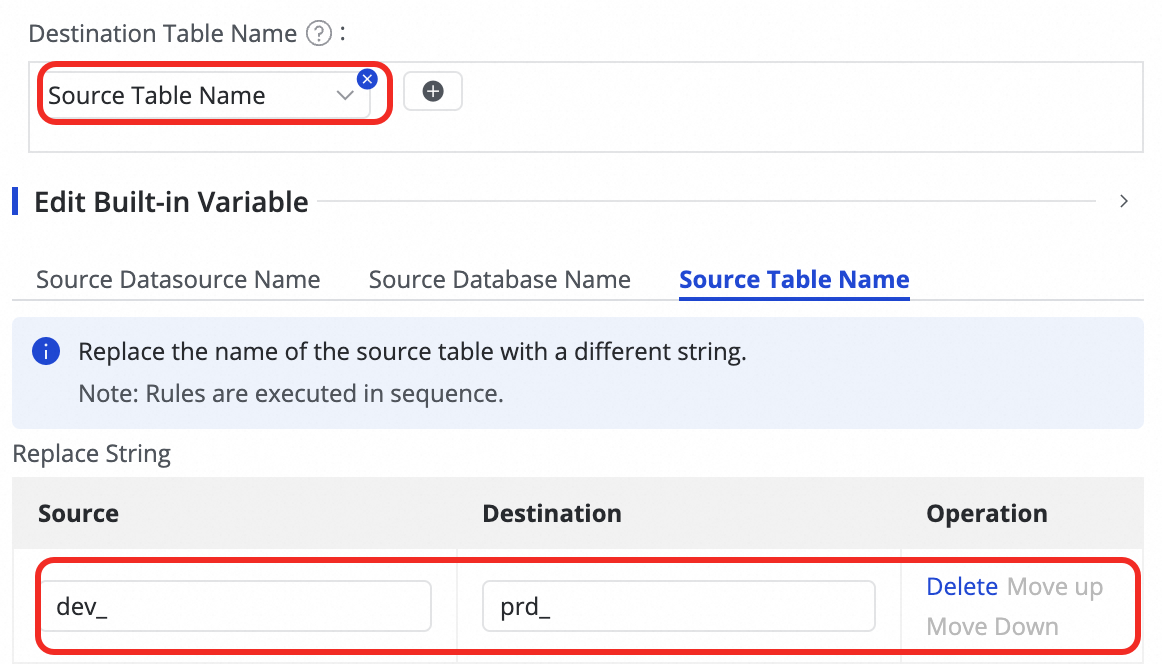



 button in the Destination Table Name column.
button in the Destination Table Name column. tooltip on the interface.
tooltip on the interface.